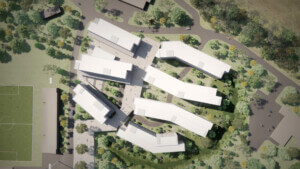“It’s a bird! It’s a dog! It’s a woman!?” To this day, no one is exactly sure what the 50-foot-tall untitled Picasso sculpture in Chicago’s Daley Plaza actually is supposed to represent. Often called “the Chicago Picasso,” the Spanish artist never revealed what or if it was supposed to represent anything at all. On the occasion of the sculpture’s 50th anniversary earlier this week, hundreds came out for a reenactment of its unveiling.
As part of the reenactment, each of the speakers from the original program were represented by new speakers. For example, in the place of the Bishop-elect, Chicago poet and songwriter Avery R. Young gave a stirring poetic invocation. Fittingly, Mayor Rahm Emanuel spoke in place of Mayor Richard J. Daley. Rather than the grand unveiling of the sculpture with a giant cloth, onlookers were provided with fans designed by Chicago artist Edre Soto to cover their eyes for the second reveal.
The sculpture was constructed by the American Bridge Company, a division of the United States Steel Corporation in Gary, Indiana, and commissioned by C.F. Murphy Associates, designers of Daley Plaza. Skidmore, Owings & Merrill (SOM) acted as architects for the sculpture and their archives provide a look into the mixed reception the artwork received in 1967. Today, the sculpture is generally considered one of the great public artworks in a city that’s also home to major pieces by Alexander Calder, Joan Miró, Marc Chagall, Jaume Plensa, and Anish Kapoor. SOM generously provided copies of letters to The Architect’s Newspaper (AN) that both praised and condemned the “pile of junk.”
“I came, I saw, I left. How could you? And you look like such a nice person too. What is it?” asked Alexander Marxen in her letter to architect-in-charge William Hartmann of SOM.
Roughly a year before the sculpture was complete, Paul Kiniery Ph.D. asked mayor Daley to cancel the whole project. “I hope very much that you, as the senior executive officer of the City of Chicago, will prevent this monstrosity from being erected in the plaza of the Civic Center. It will be humiliating and embarrassing for all of us who live in Chicago and to see this ‘thing’ when we are in the downtown area.”
Others attacked Picasso himself. In another letter to Mayor Daley, Howard F. Bickler wrote, “You see, Mr. Mayor … Pablo Picasso is a Communist. A self-admitted Communist.” Mr. Bickler had a better idea for the plaza, suggesting “a giant cross or a symbol of the American eagle.”
Harold B. Hozman felt that if people saw the work for what it was, “P. Picasso would only be another embittered, unknown, pitiful blotch.”
Yet, not everyone was quite so cynical about the Cor-ten monument.
A handwritten letter by Kathleen Chesbro, an eighth-grade student at Our Lady of Victory School, to the Mayor reads: “It expresses modern Chicago, how Chicago is now and what the people are like, and what Chicago will be in the future. Modern!”
A personal letter from fellow architect Spencer B. Cone, of Cone and Dornbusch Architects, to William Hartmann compared the piece to some other famous icons. “I’m sure the statue will become our counterpart of such attractions as the Eiffel Tower and the Great Pyramids.”
Citing rave reviews of Picasso’s show at the Tate that year, Charles A. Gianesi, M.D., chastised the Chicago American newspaper for giving “ammunition to the ignorant with front and back page exposure.” Also noting, “I don’t understand or appreciate Picasso I may some day (sic), and until then, I am content to accept the opinions of my cultural peers.”
Along with providing the letters, Eric Keune, director at SOM and an expert on the Picasso, spoke with AN about the importance of the sculpture. “This piece broke the dam and opened the floodgates for abstraction to be accepted by the public, for it to be a subject of discourse among everyday Americans. It started a chain reaction, this first, then Calder at the Federal Center, then Chagall, then Miró, Henry Moore in 70 W. Madison, Calder in the Sears tower, and on and on, all the way through Millennium Park.”










